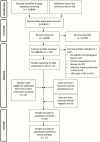Neonatal Encephalopathy With Group B Streptococcal Disease Worldwide: Systematic Review, Investigator Group Datasets, and Meta-analysis
- PMID: 29117330
- PMCID: PMC5850525
- DOI: 10.1093/cid/cix662
Neonatal Encephalopathy With Group B Streptococcal Disease Worldwide: Systematic Review, Investigator Group Datasets, and Meta-analysis
Abstract
Background: Neonatal encephalopathy (NE) is a leading cause of child mortality and longer-term impairment. Infection can sensitize the newborn brain to injury; however, the role of group B streptococcal (GBS) disease has not been reviewed. This paper is the ninth in an 11-article series estimating the burden of GBS disease; here we aim to assess the proportion of GBS in NE cases.
Methods: We conducted systematic literature reviews (PubMed/Medline, Embase, Latin American and Caribbean Health Sciences Literature [LILACS], World Health Organization Library Information System [WHOLIS], and Scopus) and sought unpublished data from investigator groups reporting GBS-associated NE. Meta-analyses estimated the proportion of GBS disease in NE and mortality risk. UK population-level data estimated the incidence of GBS-associated NE.
Results: Four published and 25 unpublished datasets were identified from 13 countries (N = 10436). The proportion of NE associated with GBS was 0.58% (95% confidence interval [CI], 0.18%-.98%). Mortality was significantly increased in GBS-associated NE vs NE alone (risk ratio, 2.07 [95% CI, 1.47-2.91]). This equates to a UK incidence of GBS-associated NE of 0.019 per 1000 live births.
Conclusions: The consistent increased proportion of GBS disease in NE and significant increased risk of mortality provides evidence that GBS infection contributes to NE. Increased information regarding this and other organisms is important to inform interventions, especially in low- and middle-resource contexts.
Keywords: group B Streptococcus; hypoxic-ischemic encephalopathy; neonatal encephalopathy; newborn; therapeutic hypothermia.
© The Author 2017. Published by Oxford University Press for the Infectious Diseases Society of America.
Figures




References
-
- Lawn JE, Blencowe H, Oza S et al. ; Lancet Every Newborn Study Group Every Newborn: progress, priorities, and potential beyond survival. Lancet 2014; 384:189–205. - PubMed
-
- Martinez-Biarge M, Diez-Sebastian J, Wusthoff CJ, Mercuri E, Cowan FM. Antepartum and intrapartum factors preceding neonatal hypoxic-ischemic encephalopathy. Pediatrics 2013; 132:e952–9. - PubMed
Publication types
MeSH terms
Grants and funding
LinkOut - more resources
Full Text Sources
Other Literature Sources
Medical

